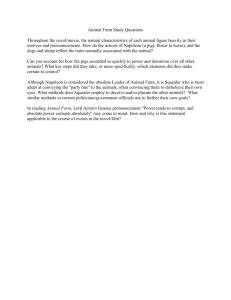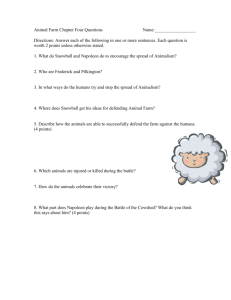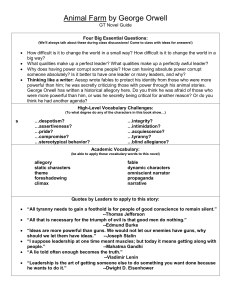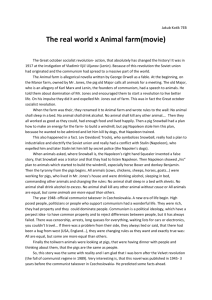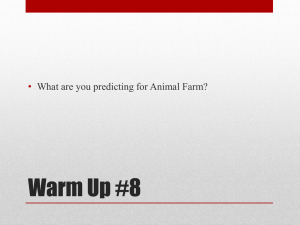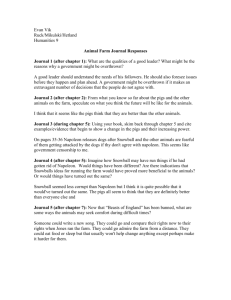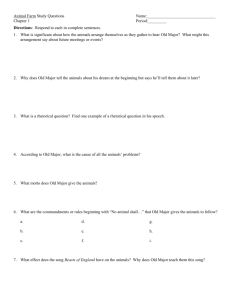While this may
advertisement
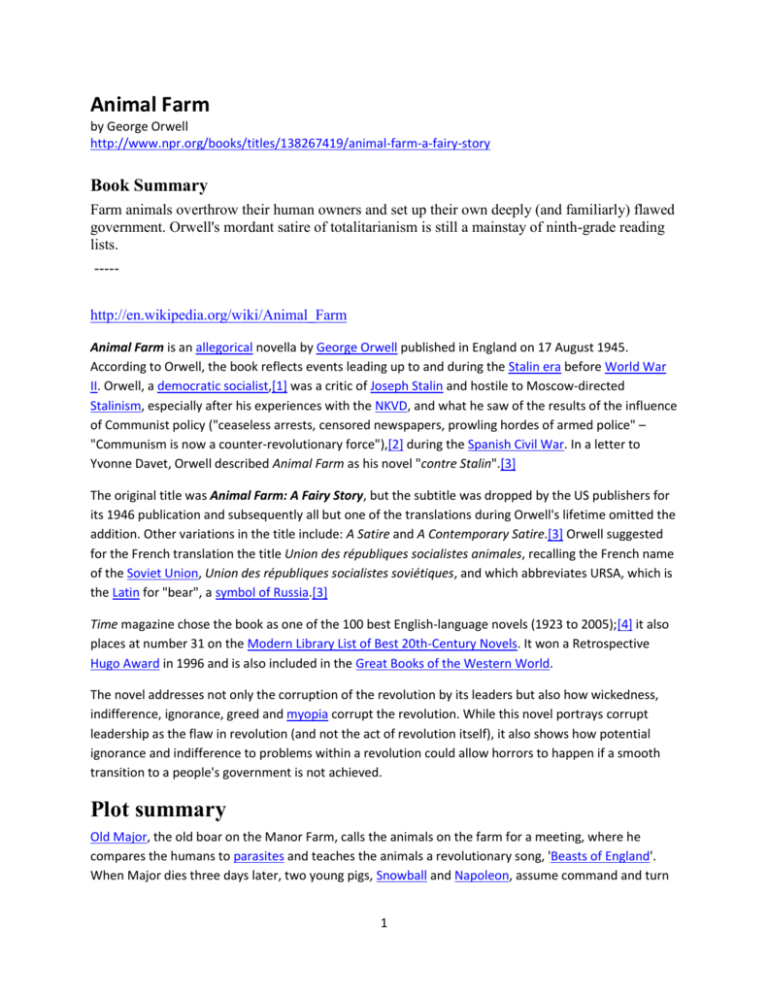
Animal Farm by George Orwell http://www.npr.org/books/titles/138267419/animal-farm-a-fairy-story Book Summary Farm animals overthrow their human owners and set up their own deeply (and familiarly) flawed government. Orwell's mordant satire of totalitarianism is still a mainstay of ninth-grade reading lists. ----http://en.wikipedia.org/wiki/Animal_Farm Animal Farm is an allegorical novella by George Orwell published in England on 17 August 1945. According to Orwell, the book reflects events leading up to and during the Stalin era before World War II. Orwell, a democratic socialist,[1] was a critic of Joseph Stalin and hostile to Moscow-directed Stalinism, especially after his experiences with the NKVD, and what he saw of the results of the influence of Communist policy ("ceaseless arrests, censored newspapers, prowling hordes of armed police" – "Communism is now a counter-revolutionary force"),[2] during the Spanish Civil War. In a letter to Yvonne Davet, Orwell described Animal Farm as his novel "contre Stalin".[3] The original title was Animal Farm: A Fairy Story, but the subtitle was dropped by the US publishers for its 1946 publication and subsequently all but one of the translations during Orwell's lifetime omitted the addition. Other variations in the title include: A Satire and A Contemporary Satire.[3] Orwell suggested for the French translation the title Union des républiques socialistes animales, recalling the French name of the Soviet Union, Union des républiques socialistes soviétiques, and which abbreviates URSA, which is the Latin for "bear", a symbol of Russia.[3] Time magazine chose the book as one of the 100 best English-language novels (1923 to 2005);[4] it also places at number 31 on the Modern Library List of Best 20th-Century Novels. It won a Retrospective Hugo Award in 1996 and is also included in the Great Books of the Western World. The novel addresses not only the corruption of the revolution by its leaders but also how wickedness, indifference, ignorance, greed and myopia corrupt the revolution. While this novel portrays corrupt leadership as the flaw in revolution (and not the act of revolution itself), it also shows how potential ignorance and indifference to problems within a revolution could allow horrors to happen if a smooth transition to a people's government is not achieved. Plot summary Old Major, the old boar on the Manor Farm, calls the animals on the farm for a meeting, where he compares the humans to parasites and teaches the animals a revolutionary song, 'Beasts of England'. When Major dies three days later, two young pigs, Snowball and Napoleon, assume command and turn 1 his dream into a philosophy. The animals revolt and drive the drunken and irresponsible Mr Jones from the farm, renaming it "Animal Farm". The Seven Commandments of Animalism are written on the wall of a barn. The most important is the seventh, "All animals are equal". All the animals work, but the workhorse, Boxer, does more than others and adopts the maxim: "I will work harder". Snowball attempts to teach the animals reading and writing; food is plentiful, and the farm runs smoothly. The pigs elevate themselves to positions of leadership and set aside special food items, ostensibly for their personal health. Napoleon takes the pups from the farm dogs and trains them privately. When Mr Jones tries to retake the farm, the animals defeat him at what they call the "Battle of the Cowshed". Napoleon and Snowball struggle for leadership. When Snowball announces his idea for a windmill, Napoleon opposes it. Snowball makes a speech in favour of the windmill, at which point Napoleon has his dogs chase Snowball away. In Snowball's absence, Napoleon declares himself leader and makes changes. Meetings will no longer be held; instead, a committee of pigs will run the farm. Using a young pig named Squealer as a "mouthpiece", Napoleon announces that Snowball stole the idea for the windmill from him. The animals work harder with the promise of easier lives with the windmill. After a violent storm, the animals find the windmill annihilated. Napoleon and Squealer convince the animals that Snowball destroyed the windmill, although the scorn of the neighbouring farmers suggests that the windmill's walls were too thin. Once Snowball becomes a scapegoat, Napoleon begins purging the farm, killing animals he accuses of consorting with Snowball. Meanwhile, Boxer takes up a second maxim: "Napoleon is always right". Napoleon abuses his powers, making life harder for the animals; the pigs impose more control while reserving privileges for themselves. The pigs rewrite history, villainising Snowball and glorifying Napoleon. Squealer justifies every statement Napoleon makes, even the pigs' alteration of the Seven Commandments of Animalism. "No animal shall sleep in beds" is changed to "No animal shall sleep in beds with sheets" when the pigs are discovered to have been sleeping in the old farmhouse. "No animal shall drink alcohol" is changed to "No animal shall drink alcohol to excess" when the pigs discover the farmer's whisky. 'Beasts of England' is banned as inappropriate, as according to Napoleon the dream of Animal Farm has been realised. It is replaced by an anthem glorifying Napoleon, who appears to be adopting the lifestyle of a man. The animals, though cold, starving and overworked, remain convinced that they are better off than they were when under Mr Jones. Squealer abuses the animals' poor memories and invents numbers to show their improvement. Mr Frederick, one of the neighbouring farmers, swindles Napoleon by buying old wood with forged money, and then attacks the farm, using blasting powder to blow up the restored windmill. Though the animals win the battle, they do so at great cost, as many, including Boxer, are wounded. Despite his injuries, Boxer continues working harder and harder, until he collapses while working on the windmill. Napoleon sends for a van to take Boxer to the veterinary surgeon's, explaining that better care can be given there. Benjamin the donkey, who "could read as well as any pig",[5] notices that the van belongs to "Alfred Simmonds, Horse Slaughterer and Glue Boiler", and attempts to mount a rescue; but the 2 animals' attempts are futile. Squealer reports that the van was purchased by the hospital and the writing from the previous owner had not been repainted. He recounts a tale of Boxer's death in the hands of the best medical care. Shortly after Boxer's death, it is revealed that the pigs have purchased more whiskey. Years pass, and the pigs learn to walk upright, carry whips and wear clothes. The Seven Commandments are reduced to a single phrase: "All animals are equal, but some animals are more equal than others". Napoleon holds a dinner party for the pigs and the humans of the area, who congratulate Napoleon on having the hardest-working animals in the country on the least feed. Napoleon announces an alliance with the humans, against the labouring classes of both "worlds". He abolishes practices and traditions related to the Revolution, and changes the name of the farm to "The Manor Farm". The animals, overhearing the conversation, notice that the faces of the pigs have begun changing. During a poker match, an argument breaks out between Napoleon and Mr Pilkington when they both play the Ace of Spades, and the animals realise that the faces of the pigs look like the faces of humans and no one can tell the difference between them. Animalism "Seven Commandments" redirects here. For the Noahide code, see Seven Laws of Noah. The pigs Snowball, Napoleon, and Squealer adapt Old Major's ideas into an actual philosophy, which they formally name Animalism. Soon after, Napoleon and Squealer indulge in the vices of humans (drinking alcohol, sleeping in beds, trading). Squealer is employed to alter the Seven Commandments to account for this humanisation, which represents the Soviet government's revisions of communist theory to make it more a reformation of capitalism than a replacement. The Seven Commandments are laws that are supposed to keep order and ensure elementary Animalism within Animal Farm. The Seven Commandments were designed to unite the animals together against the humans and prevent animals from following the humans' evil habits. Since not all of the animals can remember them, they are boiled down into one basic statement: "Four legs good, two legs bad!" (with wings counting as legs for this purpose, Snowball arguing that wings count as legs as they are organs of propulsion rather than manipulation), which the sheep constantly repeat, distracting the crowd from the lies of the pigs. The original commandments were: 1. Whatever goes upon two legs is an enemy. 2. Whatever goes upon four legs, or has wings, is a friend. 3. No animal shall wear clothes. 4. No animal shall sleep in a bed. 5. No animal shall drink alcohol. 6. No animal shall kill any other animal. 7. All animals are equal. Later, Napoleon and his pigs are corrupted by the absolute power they hold over the farm. To maintain their popularity with the other animals, Squealer secretly paints additions to some commandments to 3 benefit the pigs while keeping them free of accusations of law-breaking (such as "No animal shall drink alcohol" having "to excess" appended to it and "No animal shall sleep in a bed" with "with sheets" added to it). The changed commandments are as follows, with the changes bolded: 1. No animal shall sleep in a bed with sheets. 2. No animal shall drink alcohol to excess. 3. No animal shall kill any other animal without cause. Eventually the laws are replaced with "All animals are equal, but some animals are more equal than others", and "Four legs good, two legs better!" as the pigs become more human. Characters Pigs Old Major An aged prize Middle White boar provides the inspiration that fuels the Rebellion in the book. He is an allegory of Karl Marx and Lenin, the founders of communism, in that he draws up the principles of the revolution. His skull being put on revered public display also recalls Lenin, whose embalmed body was put on display.[6][7] Napoleon "A large, rather fierce-looking Berkshire boar, the only Berkshire on the farm, not much of a talker, but with a reputation for getting his own way",[8] An allegory of Joseph Stalin,[6] Napoleon is the main villain of Animal Farm. He begins gradually to build up his power by taking Jessie and Bluebell's newborn puppies and training them to be vicious attack dogs, whom he uses as his secret police. After driving Snowball off the farm, Napoleon usurps full power, using false propaganda from Squealer and threats and intimidation from the dogs to keep the other animals in line. Among other things, he gradually changes the Commandments for his benefit. By the end of the book, Napoleon and his fellow pigs have learned to walk upright and started to behave much like the humans against whom they originally revolted. In the first French version of Animal Farm, Napoleon is called César, the French form of Caesar,[3] although another translation has him as Napoléon.[9] Snowball Napoleon's rival and original head of the farm after Jones' overthrow. He is mainly based on Leon Trotsky,[6] but also combines elements from Vladimir Lenin.[7] He wins over most animals and gains their trust by leading a very successful first harvest, but is driven out of the farm by Napoleon. Snowball genuinely works for the good of the farm and the animals, and devises plans to help the animals achieve their vision of an egalitarian society, but Napoleon and his dogs eventually chase him from the farm. Thereafter, Napoleon spreads rumours to make him seem evil and corrupt, even claiming that he secretly sabotaged the animals' efforts to improve the farm. Squealer 4 A small white fat porker who serves as Napoleon's right hand pig and minister of propaganda, holding a position similar to that of Molotov.[6] Squealer manipulates the language to excuse, justify, and extol all of Napoleon's actions. Often attempting to confuse and disorient the animals, Squealer will make erroneous claims, like that the pigs need extra luxury in order to function properly. However, when questions persist, he usually uses the threat of the return of Mr Jones to justify the pigs' privileges. Squealer uses statistics to convince the animals that their life is exponentially improving. Most of the animals, having only dim memories of life before the revolution, are easily convinced. He is the first pig portrayed to walk on his hind legs. Minimus A poetic pig who writes the second and third national anthems of Animal Farm after the singing of "Beasts of England" is banned. The Piglets Hinted to be the children of Napoleon (albeit not explicitly stated) and are the first generation of animals actually subjugated to his idea of animal inequality. The young pigs Four pigs who complain about Napoleon's takeover of the farm but are quickly silenced and later executed. Pinkeye A minor pig who is mentioned only once; he is the pig that tastes Napoleon's food to make sure it is not poisoned, in response to rumours about an assassination attempt on Napoleon. Humans Mr Jones The former owner of the farm, Jones is a very heavy drinker and the animals revolt against him after he drinks so much that he does not feed or take care of them. The attempt by Jones and his farmhands to recapture the farm is foiled in the Battle of the Cowshed. Mr Frederick The tough owner of Pinchfield, a well-kept neighbouring farm. He buys wood from the animals for forged money and later attacks them, destroying the windmill but being finally beaten in the resulting Battle of the Windmill. There are stories of him mistreating his own animals, such as throwing dogs into a furnace. Pinchfield is noted as being smaller than Pilkington's Foxwood farm but more efficiently run, and Frederick briefly enters into an "alliance" with Napoleon by offering to buy wood from him but then betrays the deal and mounts a bloody invasion of Animal Farm. Mr Pilkington The easy-going but crafty owner of Foxwood, a neighbouring farm overgrown with weeds, as described in the book. At the end of the game, both Napoleon and Pilkington draw the Ace of Spades and begin fighting loudly. Foxwood is described as being much larger than Pinchfield, but not as efficiently run. Mr Whymper 5 A man hired by Napoleon for the public relations of Animal Farm to human society. Whymper is used as a go-between to trade with human society for things the animals can't produce on their own, at first, this is a legitimate need because the animals can't manufacture their own windmill components, but Whymper is eventually used to procure luxuries like alcohol for the pigs. Mrs Jones The wife of Mr Jones. When the animals begin their revolt, she escapes from the farm with a pillowcase filled with her possessions and pet raven Moses following behind. Her character is expanded upon in the 1999 film version, where she is at first somewhat sympathetic to the animals' plight regarding the poor care her husband gives them. Her husband passes away years later in a home for the elderly, but her final fate is unknown. Equines Boxer Boxer is a loyal, kind, dedicated, and respectable horse. He is physically the strongest animal on the farm, but impressionable (a major theme in the book), which leaves him stating "I will work harder" and "Napoleon is always right" despite the corruption. Clover Clover, a mare, is Boxer's companion, constantly caring for him; she also acts as a matriarch of sorts for the other horses and the other animals in general (such as the ducklings she shelters with her forelegs and hooves during Old Major's speech). Mollie Mollie is a self-centred, self-indulgent and vain young white mare whose sole enjoyments are wearing ribbons in her mane, eating sugar cubes, and being pampered and groomed by humans. She quickly leaves for another farm and is only once mentioned again. Benjamin Benjamin, a donkey, is one of the longest-lived animals. He has the worst temper, but is also one of the wisest animals on the farm, and is one of the few who can actually read. He is able to "read as well as any pig."[10] Benjamin is a very dedicated friend to Boxer, and does nothing to warn the other animals of the pigs' corruption, which he secretly realises is steadily unfolding. When asked if he was happier after the revolution than before it, Benjamin remarks, "Donkeys live a long time. None of you has ever seen a dead donkey." He is sceptical and pessimistic, his most-often-made statement being "Life will go on as it has always gone on – that is, badly."[10] Other animals Muriel A wise old goat who is friends with all of the animals on the farm. She, like Benjamin and Snowball, is one of the few animals on the farm who can read (with some difficulty as she has to spell the words out first) and helps Clover discover that the Seven Commandments have been continually changed. The Puppies 6 Offspring of Jessie and Bluebell, taken away from them by Napoleon at birth and reared by Napoleon to be his security force. These dogs are trained to be vicious, going so far as to rip many of the animals to shreds including the four young pigs, a sheep and various hens. They attempt to do the same to Boxer, who halts one of the puppies under his hoof. The puppy begs for mercy and through Napoleon's orders, Boxer sets the puppy free. Moses the Raven An old crow who occasionally visits the farm, regaling its denizens with tales of a wondrous place beyond the clouds called Sugarcandy Mountain, where he avers that all animals go when they die—but only if they work hard. He is interpreted as symbolising the Russian Orthodox Church, with Sugarcandy Mountain an allusion to Heaven for the animals.[11] He spends his time turning the animals' minds to thoughts of Sugarcandy Mountain (rather than their work) and yet does no work himself. He feels unequal in comparison to the other animals, so he leaves after the rebellion, for all animals were supposed to be equal. However, much later in the novel he returns to the farm and continues to proclaim the existence of Sugarcandy Mountain. The other animals are confused by the pigs' attitude towards Moses; they denounce his claims as nonsense, but allow him to remain on the farm. The pigs do this to keep any doubting animals in line with the hope of a happy afterlife, keeping their minds on Sugarcandy Mountain and not on possible uprisings. In the end, Moses is one of the few animals to remember The Rebellion, along with Clover, Benjamin, and the pigs. The Sheep They show limited understanding of the situations but nonetheless blindly support Napoleon's ideals. They are regularly shown repeating the phrase "four legs good, two legs bad". At the end of the novel, one of the Seven Commandments is changed after the pigs learn to walk on two legs and their shout changes to "four legs good, two legs better". They can be relied on by the pigs to shout down any dissent from the others. The Hens The hens are among the first to rebel against Napoleon: in response to their being forced to give more eggs, they destroy their eggs instead of handing them to the higher powers (the pigs), who want to sell them to humans. Napoleon then uses fear and starves them until the pigs get what they want. Although this results in nine of them dying, their bodies are nevertheless given decent burials in the orchard, with a cover story given related to their deaths. The Cows Their milk is stolen by the pigs, who learn to milk them, and is stirred into the pigs' mash every day while the other animals are denied such luxuries. Jessie A dog on the farm who has her puppies taken away by Napoleon for "advanced education" (these dogs later run Snowball off the farm). In the 1999 film version she is the narrator and main protagonist. The Cat Never seen to carry out any work, the cat is absent for long periods, and is forgiven because her excuses are so convincing and she "purred so affectionately that is was impossible not to 7 believe in her good intentions".[12] She has no interest in the politics of the farm, and the only time she is recorded as having participated in an election, she is found to have actually "voted on both sides".[12] Origin George Orwell wrote the manuscript in 1943 and 1944 subsequent to his experiences during the Spanish Civil War, which he described in his 1938 Homage to Catalonia. In the preface of a 1947 Ukrainian edition of Animal Farm, he explained how escaping the communist purges in Spain taught him "how easily totalitarian propaganda can control the opinion of enlightened people in democratic countries." This motivated Orwell to expose and strongly condemn what he saw as the Stalinist corruption of the original socialist ideals.[13] Immediately prior to his writing, the Ministry of Information had put out a booklet for propagandists with instructions on how to quell ideological fears of the Soviet Union, which included directions to claim that the Red Terror was a figment of Nazi imagination, and Orwell had quit the BBC.[14] In that preface, Orwell also described what gave him the idea of setting the book on a farm:[13] ...I saw a little boy, perhaps ten years old, driving a huge carthorse along a narrow path, whipping it whenever it tried to turn. It struck me that if only such animals became aware of their strength we should have no power over them, and that men exploit animals in much the same way as the rich exploit the proletariat. Orwell encountered great difficulty getting the manuscript published, as it was feared that the book might upset the alliance between the US, UK and the Soviet Union. Four publishers refused; one had initially accepted the work but declined after consulting the Ministry of Information.[15][16] Eventually Secker and Warburg published the first edition in 1945. Adaptations Animal Farm has been adapted to film twice. The 1954 Animal Farm film was an animated feature and the 1999 Animal Farm film was a TV live action version, both differ from the novel. In the 1954 sanitized version, Napoleon is overthrown in a second revolution. The 1999 film shows Napoleon's regime collapsing in on itself, as happened in the Soviet Union, appropriating the new political reality to the story. 8 Occupy Movement The Occupy movement is an international protest movement directed towards social and economic inequality, its primary goal being to make the economic structure and power relations in society fairer. Different local groups have different foci, but among the prime concerns is the claim that big corporations and the global financial system control the world in an unstable way that disproportionately benefits a minority and is undermining democracy.[7][8][9][10] Occupy Wall Street was initiated by the Canadian activist group Adbusters,[11][12][13] and partly inspired by the Arab Spring,[14][15] especially Cairo's Tahrir Square protests, and the Spanish Indignants.[16][17][18] The movement commonly uses the slogan We are the 99%, the #Occupy hashtag format, and organizes through websites such as "Occupy Together".[19] According to the Washington Post, the movement, which has been described as a "democratic awakening" by Cornel West, is difficult to distill to a few demands.[20][21] On October 12, the Los Angeles City Council became one of the first governmental bodies in the United States to adopt a resolution stating its informal support of the Occupy movement.[22] The first Occupy protest to receive wide coverage was Occupy Wall Street in New York City's Zuccotti Park, which began on September 17, 2011. By October 9, Occupy protests had taken place or were ongoing in over 95 cities across 82 countries, and over 600 communities in the United States.[23][24][25][26][27] Although most popular in the United States, Occupy has seen protests and occupations in dozens of other countries and on every continent. Each Occupy site set up a camp including tents and outdoor kitchens - in a park or other public space, often near the city or town's financial district, to establish a semi-permanent protest area. For the first two months of the protest, authorities largely adopted a tolerant approach towards the movement, though this began to change in mid November with over a dozen camps being cleared in both the US and Europe. By the end of 2011 authorities had cleared out most of the major camps. The last remaining high profile camps - at Washington DC and at St Pauls Cathredal in London - were cleared in February 2012. Yet protesters at many locations continue to organize and stage demonstrations. [28][29][30][31] The Occupy Movement attracted less attention in the Winter of 2011 compared with Autumn, as participation and activity dropped. By February 2012 several journalists began suggesting that the movement was begining to fade away, though this was frequently denied by occupiers themselves, who said they'd merely entered a less visible planning stage. By mid March activity began to increase, with Occupy activists staging high profile rallies and attempting to re-occupy their original camp in Zuccotti Park.[32][33][31][34] "We are the 99%" slogan Main article: We are the 99% The phrase "The 99%" is a political slogan used by protesters of the Occupy movement.[52] It was originally launched as a Tumblr blog page in late August 2011.[53][54] It refers to the concentration of wealth among the top 1% of income earners compared to the other 99 percent;[55] the top 1 percent of 9 income earners nearly tripled after-tax income over the last thirty years according to a Congressional Budget Office (CBO) report.[56] The report was released just as concerns of the Occupy Wall Street movement were beginning to enter the national political debate.[57] According to the CBO, between 1979 and 2007 the incomes of the top 1% of Americans grew by an average of 275%. During the same time period, the 60% of Americans in the middle of the income scale saw their income rise by 40%. Since 1979 the average pre-tax income for the bottom 90% of households has decreased by $900, while that of the top 1% increased by over $700,000, as federal taxation became less progressive. From 1992 to 2007 the top 400 income earners in the U.S. saw their income increase 392% and their average tax rate reduced by 37%.[58] In 2009, the average income of the top 1% was $960,000 with a minimum income of $343,927.[59][60][61] In 2007 the richest 1% of the American population owned 34.6% of the country's total wealth, and the next 19% owned 50.5%. Thus, the top 20% of Americans owned 85% of the country's wealth and the bottom 80% of the population owned 15% —an example of the Pareto principle. Financial inequality (total net worth minus the value of one's home)[62] was greater than inequality in total wealth, with the top 1% of the population owning 42.7%, the next 19% of Americans owning 50.3%, and the bottom 80% owning 7%.[63] However, after the Great Recession which started in 2007, the share of total wealth owned by the top 1% of the population grew from 34.6% to 37.1%, and that owned by the top 20% of Americans grew from 85% to 87.7%. The Great Recession also caused a drop of 36.1% in median household wealth but a drop of only 11.1% for the top 1%, further widening the gap between the 1% and the 99%.[63][64][65] During the economic expansion between 2002 and 2007, the income of the top 1% grew 10 times faster than the income of the bottom 90%. In this period 66% of total income gains went to the 1%, who in 2007 had a larger share of total income than at any time since 1928.[66] This is in stark contrast with surveys of US populations that indicate an "ideal" distribution that is much more equal, and a widespread ignorance of the true income inequality and wealth inequality.[67] Goals During the early weeks, the movement was criticized for having no clearly defined goals. Speaking on October 7, Kalle Lasn of Adbusters said that in the early stages demands and leaders were the "mysterious part" that allowed the movement to grow.[68] By later October, Adbusters had been trying to "rally it around a single, clear demand" for a Robin Hood tax, with a global march in support of the Robin Hood tax planned for October 29.[69][70] Naomi Wolf has argued that the impression created by much of the media that the protestors do not have clear demands is false. Wolf argues they do have clear demands including a desire to end what they see as the corrupting effect of money on politics. [71] The New Yorker magazine stated that the claims of Lasn and White were specific: tighten bankingindustry regulations, ban high-frequency trading, arrest all 'financial fraudsters' responsible for the 2008 crash, and form a Presidential commission to investigate and prosecute corruption in politics.[41] According to Bloomberg Businessweek, protesters want more and better jobs, more equal distribution of income, bank reform, and a reduction of the influence of corporations on politics.[72] The movement has also been described as broadly anticapitalist.[73][74][75] Some commentators such as David Graeber and Judith Butler have criticized the idea that the movement must have clearly defined 10 demands; they argue that issuing demands is counterproductive for the Occupy movement, because doing so would legitimize the very power structures the movement seeks to challenge.[76][77] In late November, the London contingent of the Occupy movement released their first statement on corporations, where they called for measures to end tax evasion by wealthy firms. The reason for the delay in articulating a clear demand was given as the time it takes to reach a consensus with the sometimes slow processes of participatory democracy.[78] Efforts are still underway to reach consensus with other occupy groups around the world for a global statement.[79] Methods Activists have used web technologies and social media like IRC, Facebook, Twitter, and Meetup to coordinate events.[80] Indymedia have been helping the movement with communications, saying there have been conference calls on Skype with participants from up to 80 locations. Interactive live streams of events by independent journalists such as Tim Pool have been used to augment Mainstream media coverage. The progressive provider May First/People Link offered cost-free memberships for dozens of groups, including in Iran and Germany, to host websites, emails, and email lists securely. The movement has gone further to create a diverse, multi-media culture of art production and distribution, which is being archived and gathered by institutions such as the National Museum of American History and New York Historical Society. The purpose of much of the art produced is to visually impact the mainstream through imagery to create solidarity and unity among the 99%.[81] The Community Environmental Legal Defense Fund has released a model community bill of rights for occupy organizers to adopt locally, pushing through laws that strip corporations of their personhood rights and elevating the rights of citizens.[82] In December 2011, Occupy Homes embarked on a movement to assist home owners who have lost their homes or are scheduled to lose their homes to foreclosure due to what they call the illegal practices used by banks that took advantage of consumers. The group plans to occupy foreclosed homes, disrupt bank auctions, and block evictions.[83] Structure The movement has been described as having an "overriding commitment" to Participatory democracy.[84] Much of the movement's democratic process occurs in "working groups," where any protestor is able to have their say. Important decisions are often made at General assemblies,[85] which can themselves be informed by the findings of multiple working groups. General assemblies take place at most Occupy sites every evening at 7PM. Decisions are made using the consensus model of direct democracy. This often features the use of hand signals to increase participation and operating with discussion facilitators rather than leaders - a system that can be traced in part to the Quaker movement several centuries ago, to participatory democracy in ancient Athens, and to the spokescouncils of the 1999 anti-globalization movement. [86][87][88] 11 At the assemblies, working group proposals are made to meeting participants, who comment upon them using a process called a stack; a queue of speakers that anyone can join. In New York, Occupy Wall Street uses what is called a progressive stack, in which people from marginalized groups are sometimes allowed to speak before people from dominant groups, with facilitators, or stack-keepers, urging speakers to "step forward, or step back" based on which group they belong to, meaning that women and minorities get to go to the front of the line, while white males must often wait for a turn to speak.[87][89] The progressive stack concept has been criticized by some outside of the movement as "forced equality" and "unfair."[90] Nonviolence The occupy movement began with a commitment to nonviolence. In late May 2011, sociologist Manuel Castells congratulated Spanish occupiers for that fact that not a single violent incident had been reported after 11 days of camping all over Spain.[35] Castells said that nonviolence was of fundamental importance, and was echoed by various other sociologists and social historians including Lester Kurtz, Prof. Maurice Isserman and Prof. Tom Juravich.[91][92][35] Juravich and others have however said that conflict can be important in attracting attention, with much to be gained if occupiers are seen as victims of the violence, providing occupiers keep their own aggression strictly within limits.[91] In the words of one occupier, it can help them gain media coverage if they "make things a little sexy and badass" .[93] Not all occupiers have upheld the commitment to nonviolence, with aggressive tactics being used in Spain from as early as 15th June, and with some Journalists saying the New York branch of the movement did initially accept protestors who had not signed up to nonviolence. [94][95] In September, sympathetic coverage given to the movement by the media was substantially increased after the circulation of a video of pepper spray being used by a police commander against peaceful female protestors.[91] In early October, Naomi Klein congratulated New York occupiers for their commitment to nonviolence.[96] By November 2011, media sources began to report an increase in violence, with occupiers being raped by other occupiers, at least one murder and incidents of violence from occupiers against the police, including one officer allegedly stabbed with scissors.[91][97][98] Some occupy camps have responded by requiring that all occupiers sign a resolution to be nonviolent if they wish to stay.[92] Rick Hampton for USA Today said the vast majority of occupy members have been nonviolent.[91] Reviewing the global movement in December 2011, Anthony Barnett said its nonviolence remained an immense strength.[36] In late January 2012, the movement's commitment to non violence was questioned after clashes with the police that saw about 400 arrests in the US city of Oakland. Some protestors and witnesses said the police initiated the violence, others said there was violence against the police, however they blamed black bloc anarchists and agents provocateurs. After the arrests, a survey of people in the San Francisco Bay Area found that 26% of respondents said they had withdrawn their previous support for the movement, and some leaders of the Occupy movement also distanced themselves from the events. One protester who did not take part stated, "It was organized by a very militant anarchist segment of the movement; I support the idea of taking a building, especially for housing those who don't have housing. But I don't support it with the kind of triumphal attitude I saw expressed."[99][100][95] [101] 12 The Robin Hood Tax (UK based campaigning group) Mission - To campaign for a tax on financial transactions to raise funds to protect public services, tackle poverty and climate change. Method - New media, social networking and creative marketing Motto Turning a crisis for the Banks into an Opportunity for the World. The Robin Hood tax commonly refers to a package of financial transaction taxes (FTT), proposed by a campaigning group of civil society NGOs. Campaigners have suggested the tax could be implemented globally, regionally or unilaterally by individual nations. Conceptually similar to the Tobin tax, it would affect a wider range of asset classes including the purchase and sale of stocks, bonds, commodities, unit trusts, mutual funds, and derivatives such as futures and options. The Tobin tax was proposed for foreign currency exchange only. A UK based global campaign for the Robin Hood tax was launched on 10 February 2010 [1] and is being run by a coalition of over 50 charities and organizations, including Christian Aid, Comic Relief and UNICEF.[2] The UK government published a response[3] favouring instead bank levies and a financial activities tax, citing the International Monetary Fund's report to the June 2010 G20 meeting, "A Fair and Substantial Contribution by the Financial Sector".[4] The Robin Hood tax campaign also supports both a Bank levy and a Financial Activity Tax, saying they are agnostic about the chosen mechanism providing it involves a sizable transfer of wealth from the financial sector to the needy. However most of their campaigning efforts have focussed on the FTT variant. By autumn 2011 the Robin Hood campaign had gained considerable extra momentum and support from prominent opinion formers, with a proposal from the European Commission to implement an FTT tax at EU level set to enter the legislative pipeline. The campaign has also attracted extensive criticism, with a global implementation of the FTT tax being opposed by several G20 members at the November Summit, with several EU members also opposing a regional FTT for Europe. Evaluation and reception of the Robin Hood tax Despite the early support for the FTT variant by leading statesmen such as Gordon Brown, by March 2010 The Financial Times had reported the international consensus now favoured a straightforward levy against various bank assets rather than a financial transaction tax.[43] After the June 2010 G20 meeting of finance ministers in Busan, the G20 were no longer agreed even for the less radical global bank levy, with opposition led by Canada and Australia.[44] Officials from EU, USA and UK said they were still planning to implement levies on their own banks, although the tax would likely be at a lower rate now to limit the risk of banks moving to jurisdictions that aren't planning on implementing the levy. Following on from the Pusan meeting but prior to the main 2010 G-20 Toronto summit, the European Union president Herman Van Rompuy announced that the EU had a common position in favour of both a Robin Hood style transaction tax and a bank levy which they would push for at the G20 gathering. However, according to the Canadian Embassy Newspaper there were divisions within the EU with some member countries such as the Czech Republic against any form of bank tax. [45] [46] No consensus for the tax 13 emerged from the 2010 G20 summit. Prior to the 2011 G20 Summit in November, the Robin Hood campaign had became even more prominent, though it also provoked dozens of critical articles. Again it failed to achieve consensus at the 2011 summit. General Criticism The proposed FTT could reduce the total volume traded in financial products, with negative consequences for employment. While this may reduce employment in brokerages and other areas of the securities industry, a further consequence could be unemployment outside of the financial sector. Schwabish (2005) examined the potential effects of introducing a stock transaction (or "transfer") tax in a single city (New York) on employment not only in the securities industry, but also in the supporting industries. A financial transactions tax could lead to job losses also in non-financial sectors of the economy through the so called multiplier effect forwarding in a magnified form any taxes imposed on Wall Street employees through their reduced demand to their suppliers and supporting industries. The author estimated the ratios of financial- to non-financial job losses of between 10:1 to 10:4, that is "a 10 percent decrease in securities industry employment would depress employment in the retail, services, and restaurant sectors by more than 1 percent; in the business services sector by about 4 percent; and in total private jobs by about 1 percent." [47] Other unintended consequences of an FTT could include a reduction in professional market participants such as market makers who stand ready to buy or sell at prevailing prices. This could impact the orderly and efficient operation of markets, including the price discovery process. It has been suggested that such reforms could lead to reduced liquidity, wider bid / offer spreads, and greater volatility.[48] According to the United States Chamber of Commerce, the tax could double the cost of certain financial transactions and could cause the Dow Jones Industrial Average to fall by 12.5%.[49] Mike Devereux, director of the Centre for Business Taxation at Oxford University, has argued the tax would effectively be a stealth tax as the banks would pass all costs on to their customers, with no guaranteed transparency about who exactly would bear the costs.[50] Economics writer Tim Worstall has made similar arguments, stating the tax would ultimately be paid not by the banks but by ordinary consumers and workers. Worstall also argues that overall an FTT tax would reduce tax revenue, so would fail to help provide extra money for helping the poor.[51] In 2011 Oxfam banned a pensioner from one of its stores as he was incensed by the organization's support for the tax, feeling that it could reduce the income of small time pensioners and shareholders like himself.[52] Criticism against implementation at national or regional level only If implemented just at EU level rather than globally, critics has stated the negative consequences would be felt disproportionately in Britain, with economists such as Tim Congdon estimating an FTT could result in over 100,000 job losses from London's financial sector.[53] [54] 14 Andrew Tyrie, Chairman of the UK Treasury Select Committee, has listed 17 problems with the FTT tax including a loss of overall tax revenue for Britain.[54] Critics have conceded that the FTT would reduce the overall volume of transactions especially those originating from High-frequency trading, but deny that it would reduce the risk of further crises in the financial sector.[54] When a 0.5% financial transaction tax was implemented in Sweden, over 50% of trades in Swedish equities moved to London.[53] On 15 April 1990, the tax on fixed-income securities was abolished. It is notable that the tax imposed an increased cost on government borrowing, and this may have influenced the decision to repeal the tax.[55] Public opinion A recent Eurobarometer poll of more than 27,000 people published in January 2011 found that Europeans are strongly in favour of a financial transaction tax by a margin of 61 to 26 per cent. Of those, more than 80 per cent agree that if global agreement cannot be reached - an FTT should, initially, be implemented in just the EU. Support for an FTT, in the UK, is 65 per cent. Another survey published earlier by YouGov suggests that more than four out of five people in the UK, France, Germany, Spain and Italy think the financial sector has a responsibility to help repair the damage caused by the economic crisis. The poll also indicated strong support for an FTT among supporters of all the three main UK political parties.[37][56] Despite the arguments that a EU only FTT tax would hurt Great Britain, other 2011 polls have suggested about two thirds of the British public support the Robin Hood tax campaign.[54] http://en.wikipedia.org/wiki/Robin_Hood_tax ----- Youtube audio book (Animal Farm): http://www.youtube.com/watch?v=0Mcep34DH_s ----Animal Farm - Synopsis (Youtube) http://www.youtube.com/watch?v=aybo5lYPx4s&feature=related ----Animal Farm" SUMMARY/OVERVIEW -- George Orwell's "Animal Farm" ... from 60second Recap http://www.youtube.com/watch?NR=1&v=_dI1YO3EGYs&feature=endscreen 15
